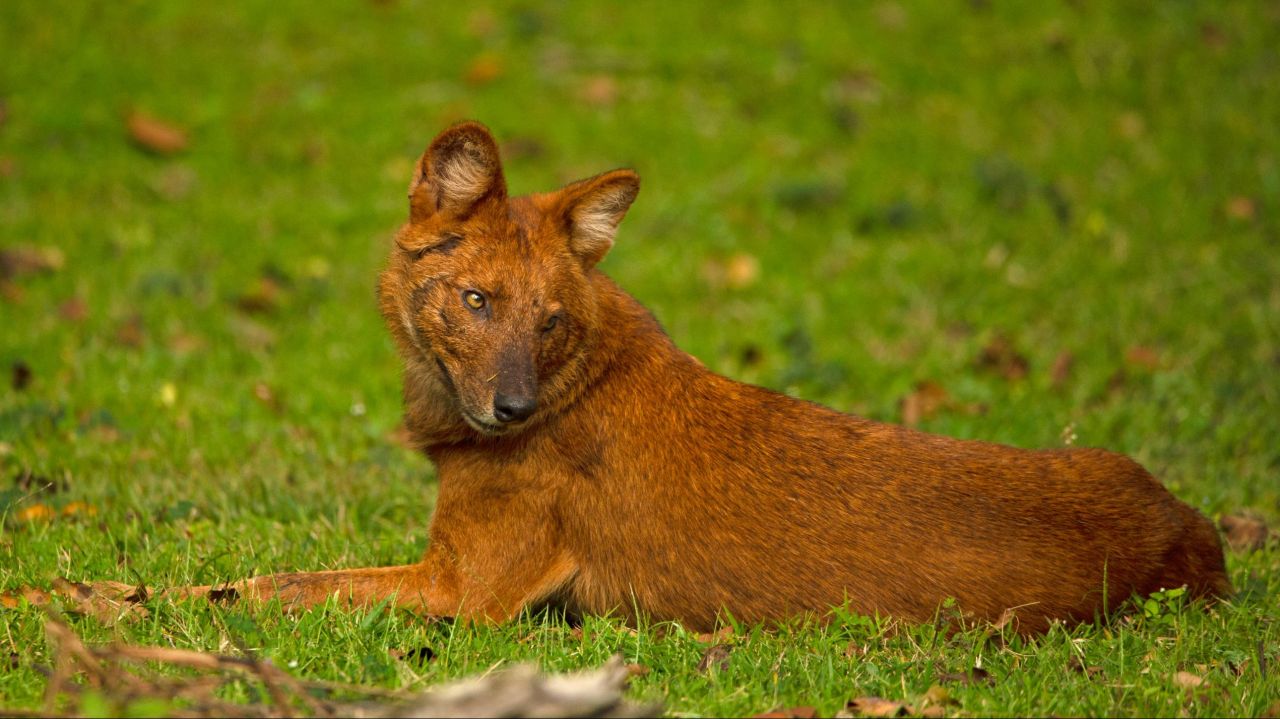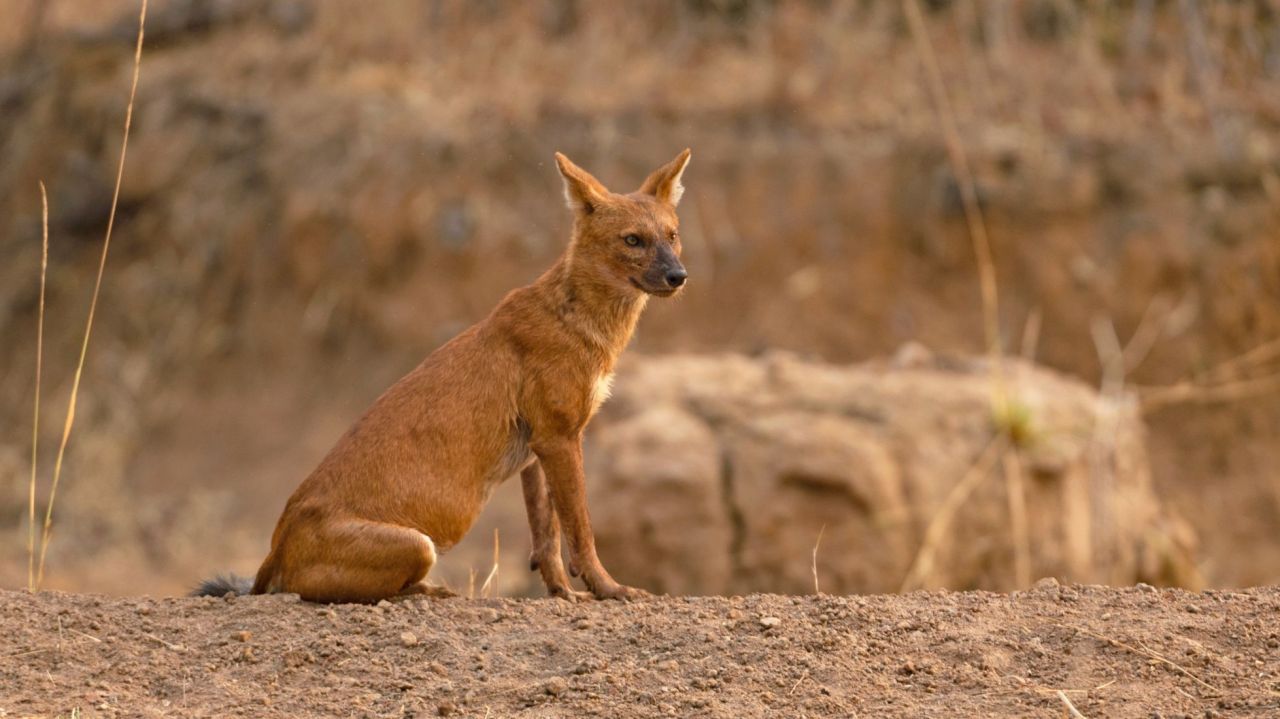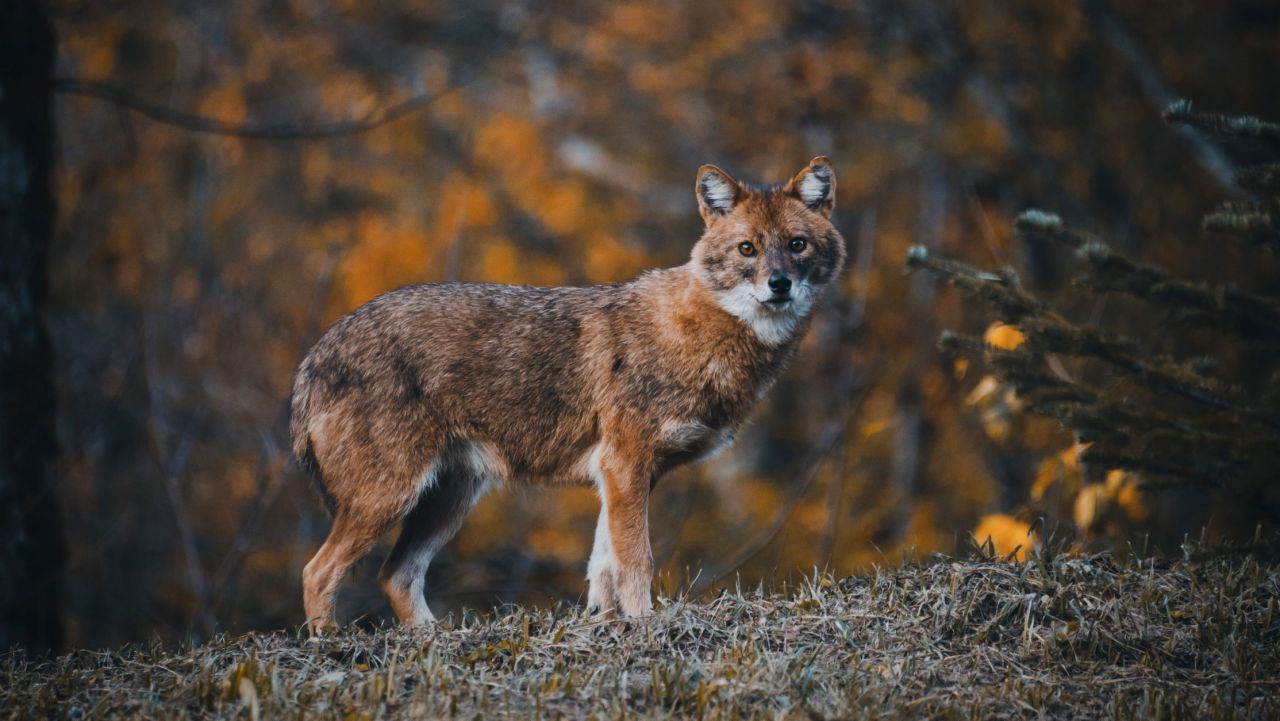Dhole (Cuon alpinus): a canid native to Central, South, East and Southeast Asia.
AKA: Asian wild dog, Asiatic wild dog, Indian wild dog, whistling dog, red dog, red wolf, and mountain wolf.
Kingdom: | Animalia
Phylum: | Chordata
Class: | Mammalia
Order: | Carnivora
Family: | Canidae
Genus: | Cuon
Species: | C. alpinus

Size and Weight:
Dholes are only about the size of a border collie. They are 3 feet in length and 20 inches tall at the shoulder. Their tail is 15 to 18 inches long. Males are slightly larger and heavier than females. Females weigh 22 to 29 pounds and males weigh 33 to 44 pounds.
Appearance:
Depending on their habitat, these wild dogs vary in color from charcoal gray to rust red to sandy beige. They have a long, brushy, fox-like tail that often has a black tip. They usually have a white belly, chest, and feet. Adults have rounded ears and a pointed snout.
Diet:
Their diet varies depending on their habitat, but they typically feed on hoofed mammals. In India, they eat deer, wild pigs, buffalo, and wild goats. In Southeast Asia, dholes feed on deer, gaur, and banteng. And in Siberia, they eat deer, wild sheep, and reindeer. When hunting larger prey, they often hunt as a pack. A pack is capable of taking down prey over 10 times their own body weight. When hunting solo, a dhole may also feed on berries, bugs, lizards, and rabbits.
Dholes maintain a very large territory of up to 34 square miles, helping them to find enough food to eat. Their territory is often shared with larger predators like tigers and leopards, so the pack must be alert. One dog often leads the pack during a hunt. They communicate throughout the hunt with various sounds. This communication, plus their incredible athleticism, helps them take down large prey. With teeth like razors, dholes can consume a quarter of their own body weight in ten minutes.
Habitat:
Dholes occupy a wide variety of climates and habitats, such as dense forests, scrub, steppes, and alpine regions.
Geography:
Dholes are found in Central, South, East and Southeast Asia.

Breeding:
The breeding season occurs in November and December, which includes two weeks of courting and two weeks of breeding. In a pack of dholes, there is one dominant monogamous pair. The entire pack helps to care for and feed that pair’s pups. After a gestation period of 60 to 62 days, the female gives birth to a litter of up to 12 pups, which is more teats than other canid species.
While the mother is nursing, other members will bring food to her and the pups by regurgitating it from their stomachs after a hunt. The pups remain at the den site for 70 to 80 days. By the age of six months, the pups accompany the adults on hunts and are allowed first dibs on the kills. By eight months of age, they assist the adults with the killing of larger prey. The pups reach sexual maturity at about three years of age, at which time, the females head off to live with other packs.
Social Structure:
Like other wild dog species, dholes are social animals that live in groups called packs. Each pack has 5 to 12 members that care for the young, hunt and feed together. Members may also work or play with dholes from outside of their own pack. Sometimes various packs form super packs of up to 30 dogs. Super packs hunt together, share their prey, and then separate again into the original smaller groups. Inter-pack aggression is rare. Dhole packs live in burrows with multiple entrances.
Dholes are one of the most talkative canid species. They have eleven distinctive calls that are used for different situations. At play, they whine and whimper. They also cluck, scream and mew. They are perhaps best known for their whistle. While hunting as a pack, the low-frequency whistle call carries farther and is easier to hear through thick forest foliage. The whistling sound is so distinct that it can be used to identify individual animals.

Lifespan:
Dholes live about 10 years in the wild and up to 16 years in captivity.
Threats:
The greatest threat to dholes is habitat loss and fragmentation. As human activity expands, dholes are losing their places to live, reproduce and feed. Not only are dhole at risk, but so is their prey. In 2008, there were estimated to be less than 2,500 adult dholes in the wild.
Other threats include disease and human conflict. These wild dogs can easily catch diseases like distemper and rabies from domestic dogs brought by humans moving into the wild dogs’ habitat. Dholes are viewed as dangerous pests in some areas and are trapped and poisoned as a result.
Conservation Status:
As of 2015, the IUCN has classified the dhole as Endangered on its Red List of Threatened Species.
Conservation Efforts:
Scientists and conservationists are working to better understand dholes. For example, scientists at the Smithsonian Conservation Biology Institute’s Center for Species Survival (CSS) are working to study and save dholes by tracking animals with satellite collars, monitoring human-dhole conflict, and doing community outreach.
Source: NATURE’s miniseries “Dogs in the Wild” and the San Diego Zoo Wildlife Alliance.
